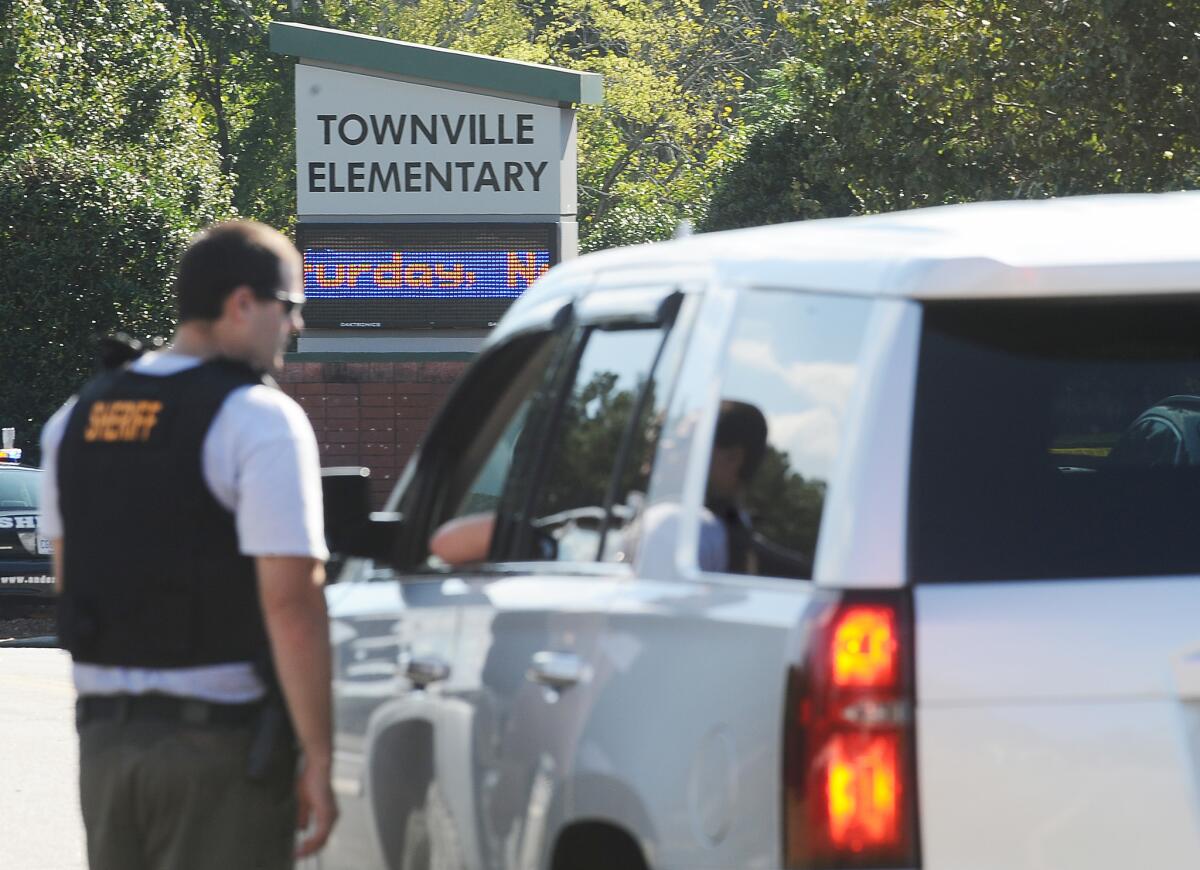What should schools do when a second-grader makes a threat?

Last month, Parkview Elementary School mom Amber Dunevant was told that one of her 7-year-old daughter’s classmates had put her daughter on a “kill list.”
Dunevant said she saw the list in the school principal’s office. She saw that it had the names of her daughter and a few other students written on green construction paper.
Chula Vista police said they investigated and believed the threat was not credible; they found that the second-grade boy who wrote the list had no access to weapons. Police said Parkview, which is in the Chula Vista Elementary School District, provided intervention services to the student.
The school’s response didn’t satisfy Dunevant, who said the boy who made the list was still at school and in the same class as school officials investigated the incident. She said she was going to have her daughter transferred to another class because she didn’t feel safe.
“I feel bad. I want him to get help but not at the expense of my daughter’s safety,” Dunevant said. “This is a big deal and I feel like they’re brushing it aside, they’re letting him off easy.”
Such threats are more than just a discipline issue, child experts and school officials say. Schools say they have to balance the safety of all students and staff along with the privacy and emotional well-being of the student who made the threat.
“It is a balancing act,” said Anthony Millican, spokesman for the Chula Vista district. “What we try to convey is that, keep in mind, these are elementary students.”
The issue of how to properly assess school threats has become an increasingly common one for schools in recent years, even in elementary-only school districts such as Chula Vista. The district of about 23,000 students hired an emergency preparedness and security manager, Sherry Stone, three years ago specifically to help schools write safety plans and conduct safety drills and training.
Schools in Chula Vista and elsewhere say they are dealing with more threats partly because the range of what is considered a threat has expanded in recent years, as more school shootings have made the public more wary and sensitive to possible school violence. Comments or incidents that may not have been taken so seriously years ago are now treated as potential threats, Millican said.
“Things that we now report as a threat, we would’ve dismissed rightly or wrongly” several years ago, Millican said. “In quote-unquote ‘old days,’ we wouldn’t have given it another look other than say, ‘Don’t use that word.’ Now, it becomes documented.”
Though it’s not unheard of for young children to make threats, some school officials say it’s more likely than not that such children would lack the means to carry out threats. Still, it’s important to not assume that a student won’t hurt anyone just because they are, say, 7 years old or the captain of the debate team, said Barbara Higgins, director of safety and student engagement for the San Diego County Office of Education.
“In this climate, we have to take that stance that every issue, every instance gets dealt with until we know what we’ve got,” Higgins said.
Child mental health experts say adults should investigate and consider the life circumstances of youths who make threats. Often, children who make threats do so out of anger or frustration that may have been caused by other factors in their life, such as troubles at home or in their communities, said Mark Reinecke, child and adolescent psychologist and clinical director of the Child Mind Institute in San Francisco. Threats can be a youth’s attempt to control what’s happening around them, Reinecke said.
“For sure, having a second-grader having a hit list is distressing to everyone. It’s an unusual thing and should be taken seriously,” Reinecke said. “But take the broad view: Where is this coming from in this individual child’s life, and what do we need to do to address it to help this youngster?”
Simply suspending or otherwise punishing a student for making a threat may not help the student, some experts say. For example, suspending a student could cause the student to stew at home about how they had been punished, Stone said, and the suspension puts the school out of close contact with the student.
Overreacting to certain threats can end up negatively labeling a youth, said Desiree Shapiro, a child and adolescent psychiatrist at Rady Children’s Hospital in San Diego. It could also lead to more stress for other children.
“Perhaps a threat may have come from a place of anger or frustration, and understanding that or supporting youth will lead to a better outcome instead of punishing them or penalizing them,” Shapiro said.
Just because a student makes a threat doesn’t necessarily mean that student is going to physically hurt somebody.
“People make threats all the time,” Higgins said. “Do they have the means, have they done the planning to carry out an attack? That’s a whole different story.”
The key to properly assessing school threats is having a multidisciplinary team at each school that is ready to investigate threats that arise — a team that often includes a school administrator, counselor, psychologist, social worker or police officer, Higgins said. By conducting interviews and gathering evidence, staff can determine whether the student who made the threat posed a danger.
Assessment teams will deem some threats to be transient, meaning they do not express a serious intent to harm someone or can be easily resolved. Substantive threats, in which there is a serious intent to harm somebody, require more serious responses.
Both the San Diego County Office of Education and Chula Vista Elementary School District follow these guidelines as part of the Dewey Cornell model, a school threat assessment model developed at the University of Virginia in 2001 that they say is the only evidence-based model they have found.
Parents such as Dunevant can get frustrated by how schools handle threats because schools can’t reveal the details behind their threat assessments. For one thing, school officials say, federal laws prevent them from disclosing how they disciplined a student and other personal details.
“What they don’t see is all the conversations and interventions we’re putting on for this kid,” Stone said. “It’s frustrating for us and it’s frustrating for other parents that we can’t say it, but we’re bound by the laws.”
Even if a threat is found to be transient, Higgins says, it still deserves intervention, such as counseling, and it can still involve severe discipline or other consequences. For more serious substantive threats, interventions can include referrals to outside agencies, mental health assessments, counseling, conflict mediation, safety plans or changing of classrooms or transportation routes, Stone said.
In the case of the student at Parkview Elementary, experts said it sounded like the Chula Vista district responded appropriately.
“The system here worked as it should: Somebody saw it, somebody picked up on the signal here that there’s a risk here for this youngster, and they intervened…. They reached out their hand and helped this child,” Reinecke said.
Taketa writes for the San Diego Union-Tribune.
More to Read
Start your day right
Sign up for Essential California for news, features and recommendations from the L.A. Times and beyond in your inbox six days a week.
You may occasionally receive promotional content from the Los Angeles Times.







